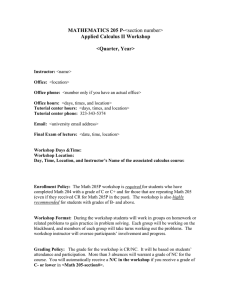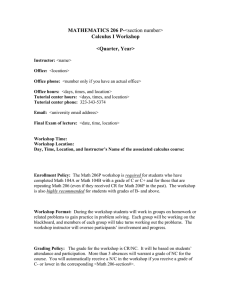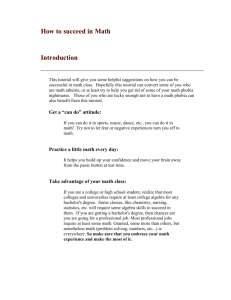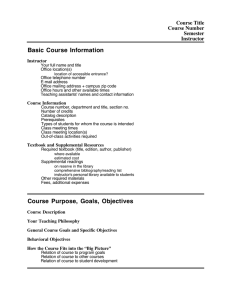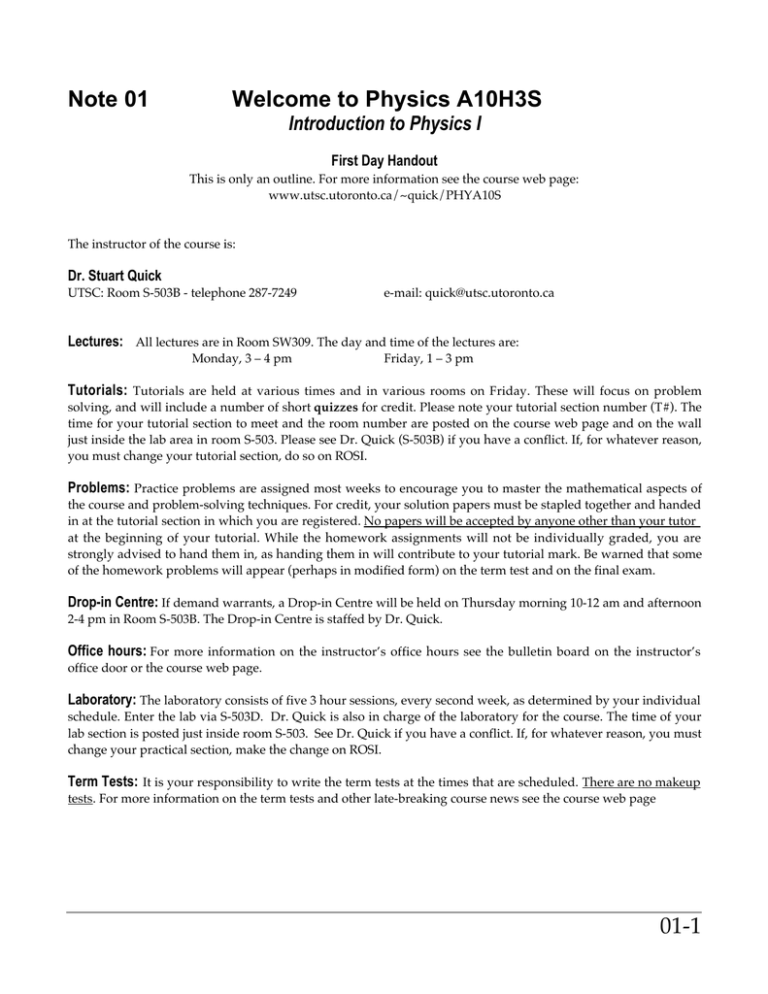
Note 01
Welcome to Physics A10H3S
Introduction to Physics I
First Day Handout
This is only an outline. For more information see the course web page:
www.utsc.utoronto.ca/~quick/PHYA10S
The instructor of the course is:
Dr. Stuart Quick
UTSC: Room S-503B - telephone 287-7249
e-mail: quick@utsc.utoronto.ca
Lectures: All lectures are in Room SW309. The day and time of the lectures are:
Monday, 3 – 4 pm
Friday, 1 – 3 pm
Tutorials: Tutorials are held at various times and in various rooms on Friday. These will focus on problem
solving, and will include a number of short quizzes for credit. Please note your tutorial section number (T#). The
time for your tutorial section to meet and the room number are posted on the course web page and on the wall
just inside the lab area in room S-503. Please see Dr. Quick (S-503B) if you have a conflict. If, for whatever reason,
you must change your tutorial section, do so on ROSI.
Problems: Practice problems are assigned most weeks to encourage you to master the mathematical aspects of
the course and problem-solving techniques. For credit, your solution papers must be stapled together and handed
in at the tutorial section in which you are registered. No papers will be accepted by anyone other than your tutor
at the beginning of your tutorial. While the homework assignments will not be individually graded, you are
strongly advised to hand them in, as handing them in will contribute to your tutorial mark. Be warned that some
of the homework problems will appear (perhaps in modified form) on the term test and on the final exam.
Drop-in Centre: If demand warrants, a Drop-in Centre will be held on Thursday morning 10-12 am and afternoon
2-4 pm in Room S-503B. The Drop-in Centre is staffed by Dr. Quick.
Office hours: For more information on the instructor’s office hours see the bulletin board on the instructor’s
office door or the course web page.
Laboratory: The laboratory consists of five 3 hour sessions, every second week, as determined by your individual
schedule. Enter the lab via S-503D. Dr. Quick is also in charge of the laboratory for the course. The time of your
lab section is posted just inside room S-503. See Dr. Quick if you have a conflict. If, for whatever reason, you must
change your practical section, make the change on ROSI.
Term Tests: It is your responsibility to write the term tests at the times that are scheduled. There are no makeup
tests. For more information on the term tests and other late-breaking course news see the course web page
01-1
Note 01
MATERIALS
Materials except the lab manual are sold in the Bookstore; manuals are sold in Room S-644.
Textbook: Physics for Scientists and Engineers with Modern Physics by Randall D. Knight (Pearson/Addison
Wesley, 1st Edition, 2004). Accompanying the text is a Student Workbook and a CD-ROM Student Access Kit for
MasteringPhysics, an online tutoring system..
Lab Manual: PHYA10H3F/PHYA10H3S/PHYA21H3S Laboratory Manual 2004/2005
Lab Workbook: University Physics Notebook (black cover)
Calculator: Any scientific calculator will be adequate. Only calculators that have no alphanumeric keyboard may
be used for the quizzes, term test and the final exam.
Set of Drawing Instruments: Highly recommended.
PREREQUISITES and COREQUISITES
The prerequisites and corequisites are as printed in the UTSC Calendar for 2004-2005. If you have any question on
these ask Dr. Quick.
MARKING SCHEME
Laboratory .....
Tutorials ...
Term tests .......
Final exam .....
25% (based on attendance, lab notebook, two formal reports)
10% (based on participation in tutorials including problem sets and quizzes)
20%
45%
If you miss a test, homework assignment or lab report you will be given zero unless you provide the instructor
with an acceptable explanation in writing. In the event you are ill, you must provide Dr. Quick with a doctor's
certificate within 5 working days after the test.
HONESTY
With the exception of exams, tests, and quizzes, you may discuss problems and homework assignments with
others so long as you turn in your own work. Any discussions are part of the learning process; once you learn
how to solve a problem you are expected to solve it by yourself, and the solution you turn in must be your own
work. It is a serious academic offence to turn in any solution you have copied from the work of someone else. For
more information on plagiarism see the course web page.
WEB PAGE
The primary source for up-to-date course information is the course web page. You can access the page directly via
the URL given at the top of the first page of this handout or via the Physical and Environmental Sciences Home
Page. On the web page you will find the course outline, lecture notes (this series of documents), lecture schedule,
and the current homework assignment. You will need to enter a user name and a password (to be supplied in
class) to access the lecture notes and the homework assignments.
01-2
Note 01
What is Physics?
Calendar Description
Physics is the study of the basic laws that govern how
material objects move and influence each other. The
effect of a star on the motion of a planet, of the Earth
on the motion of a satellite, the effect of a molecule on
a nearby atom, or of an atomic nucleus on an electron,
can be accurately described by the laws of physics.
Although Newton’s laws of motion adequately
describe some of these situations, in most cases it is
necessary to apply the most recently discovered
refinements of these laws—quantum mechanics and
the theory of relativity, together with the understanding of electric and magnetic effects so beautifully
synthesized in Maxwell’s theory of electromagnetism.
From these basic principles many of the properties of
gases, liquids, solids, plasmas, and nuclear matter can
be related to the interactions among the individual
units of which these forms of matter are composed.
h1
h?
30˚
45˚
A
B
C
Figure 1-1. A favorite demonstration of instructors consists
of three straight sections of metal track. If a ball is released
from position A it will roll down the track and briefly come
to rest at some position F. Is h = h1? Why or why not?
C
Physics is a Construct
From the beginning you should understand that
physics, like all sciences, was developed in stages by
generations of men and women working over many
years. And it continues to be developed today. As
such it is a human invention—a construct built on
basic and arbitrary (though well-thought-out)
definitions, standards and laws. Though the standards
may be arbitrary (other standards might easily have
been agreed upon) they are applied by physicists in a
consistent way to make the subject as intelligible as
possible. A physical law, too, is a construct; it is a
succinct statement of the working of a certain kind of
phenomenon, a working that is borne out by
experimental evidence. If evidence is found that is not
described by the law, then the law must be changed.
This is the way of science. So as you read these notes
be alert to the constructs when they appear. Examples
of constructs are Newton’s laws of motion, energy, the
field and many others.
Questions Physics Attempts to Answer
Physics is the science that attempts to answer the most
basic questions (Figures 1-1 and 1-2 illustrate two of
the simplest). Why do objects, when released, fall
toward the Earth? Why do the planets revolve around
the Sun? Why does light behave as a particle in some
situations, and as a wave in others? Why can’t we
travel faster than the speed of light? Your instructor
will no doubt demonstrate in class some of the effects
that physics attempts to describe.
B
A
320 m
Figure 1-2. A ball is projected horizontally from some
position above the earth. What approximate path, A, B or C
does the ball take and why?
Questions Frequently Asked
Students frequently ask a number of questions about
the PHYA10/PHYA21 courses. We have collected a
few of them here.
• Is PHYA10 a Repeat of High School Physics?
The answer is partly yes and partly no, but mostly no.
There is always some overlap between a course and
what has gone before. Physics is constructed like a
building with a foundation of definitions, standards
and mathematical techniques. The building blocks
laid on this foundation are the laws of motion, conservation of energy and momentum, topics of heat and
light and so on. The mastery of topics in physics and
mathematics takes time. The level of PHYA10 is
higher than most high school physics courses because
it makes use of concepts of functions and calculus to
01-3
Note 01
name two. Mathematics is inseparable from physics.
But the level of understanding provided by
PHYA10 in turn, is limited too. PHYA10 is itself a
prerequisite for courses in electricity and magnetism
and others in the second and third years that build on
topics covered here.
• Why is Calculus a Corequisite of the Course?
Calculus is a corequisite of the course because
calculus is so important to physics. Calculus was
invented to make the description of certain things
possible (and easier).
• What is Expected of Me?
In this course you will have to read a good deal. You
will have to read these notes. You will have to read
the textbook. You will have to read the Students’
Workbook. You will have to read the laboratory
manual. The more you read the better prepared you
will be for appreciating the subtleties of physics, and
the connections that exist between the theoretical and
experimental aspects of the subject. So be prepared to
read, read, read.
• What is Meant by “Describing”?
In these notes we use the word “describe” quite often.
Physics is the science that attempts to explain or
describe things—objects in freefall, the motion of a
projectile, the motion of the Earth around the Sun, the
nature of light. The word “describe” means to explain
the phenomenon, not just in words, but more
importantly, in the language of mathematics. When
we say we shall describe the motion of a projectile, for
example, we mean we shall derive from basic ideas
and definitions the position of the projectile and how
that position changes with time as a mathematical
function. Indeed, it could be said that mathematics is
the language of physics. Physical proofs are presented
as mathematical descriptions.
Now, there is no guarantee that a mathematical
description will be correct in all cases. This is where
experimental physics and the lab comes into play.
Indeed, as we shall attempt to show in these notes and
in the laboratory, experimental data is crucial in
proving or disproving mathematical descriptions. All
this is consistent with what we have stated earlier,
that physics is a construct developed in stages.
• Why is there a Physics Lab?
We have already given one reason for a lab in the
previous section. Part of the experience of
PHYA10/PHYA21 consists of a laboratory. Physics is
01-4
as much an experimental science as it is a theoretical
one. Only by working with real instruments in a real
physics lab can you appreciate what physics is.
Without a laboratory, a physics course would be just
applied mathematics, the solving on paper of
carefully-crafted problems.
In the physics lab you will use high-quality instruments, the kind that real scientists use in research or
in industry. You will receive a technical training that
will stand you in good stead in later studies in physics
and in other sciences. In the physics lab you will write
formal reports, not so much for the purpose of being
tested, as for the purpose of learning how to express
yourself in the English language and the language of
science. Report writing is vital in all the sciences, as it
is in history or business studies.
• What Should I Study from, the Notes or Text?
We have chosen the textbook for this course because
we think it a good one. This book attempts to address
many of the misconceptions held by many first year
students. It is designed to get you thinking about the
concepts of physics, to teach you an understanding of
the subject, and not just to train you to get the correct
answer in a physics problem. Indeed, be warned that
the questions on the quizzes, tests and exams in this
course have been selected to test you as much on the
concepts of physics as on getting a correct numerical
answer.
However, the physics textbook is rather long (not to
mention heavy!). After all, it is intended to be complete. It is your source to consult for the fine details. It
is a kind of physics encyclopedia. It has many more
examples than any instructor can hope to cover in the
lectures.
We suggest, then, that you use these course notes to
guide what you read from the textbook. For many
topics, the course notes follow the textbook closely
(indeed, to the point of using the same graphics).
Other topics are presented from the instructor’s point
of view. The course notes will tell you which sections
in the textbook you will be tested on, which sections
you should read for your own interest, and which
sections you may omit altogether.
OUR GUARANTEE!
You will be tested only on the physics concepts
covered in the course notes.

